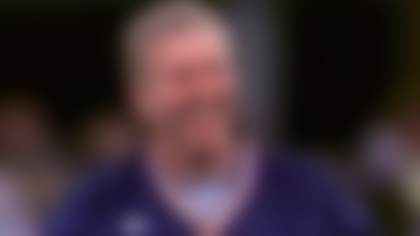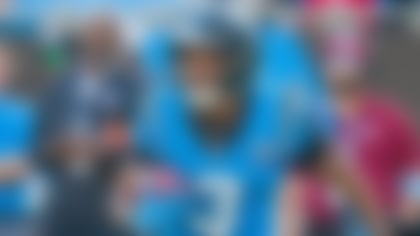FOXBOROUGH, Mass. -- The record will show the Patriots dealt Randy Moss to the Minnesota Vikings on Oct. 6, 2010. But preparations for the blockbuster, from New England's perspective, were pushed into motion almost a year earlier than that.
And as soon as the Patriots pulled the reins in on their wide-open, spread attack, the idea of trading Moss became palatable. Easy? It never is, to trade away a talent like Moss.
What the evolution of the New England offense has done, though, is shift that prospect from the impossible to the improbable, then to a consideration and, finally, a reality in a 10-month span. So Moss is gone now, and the Patriots are ready for that.
When juxtaposed against the Deion Branch trade of 2006 -- a move that shipped the Super Bowl XXXIX MVP out of town with the team already needy at his position -- this one doesn't look so bad. Branch has returned, but he's just a part of the reason why New England's offense hardly figures to go careening off a cliff after losing one of the greatest receievers ever to slip on a pair of shoulder pads.
"The roster's always in transition with players getting injured and players moving," quarterback Tom Brady said on Wednesday. "I think it's something I'm used to. We put a good day of work in yesterday, and I'm excited to see what we do this weekend."
This isn't exactly akin to putting some backup with a bum hammy on injured reserve, so take Brady's words with a grain of salt. There are things that Moss could do for the Patriots -- or any team, really -- that change the way the defense approaches an offense and lightens the load for the other four skill players surrounding the quarterback.
Those won't be replaced. Period. And the idea isn't necessarily to try.
It's more to get to the same destination -- the end zone -- using a different route. If riding Randy Moss to paydirt is like taking the interstate, then this might feel a little more like using the back-road shortcut that only the locals know.
The concept has worked in New England before, when so many on the outside had trouble identifying what made New England so tough to beat. The second-highest scoring Patriots team of the Belichick Era, the 2004 edition, had a leading receiver, David Givens, with 56 catches. Seven different skill players on that team had 15 or more receptions, and the team's need to threaten defenses down the field was filled by David Patten and Bethel Johnson, neither of whom will ever be mistaken for Brett Favre's new top target.
The trouble with that idea is this: In that world-championship season, New England also had an overpowering running game, behind bellcow Corey Dillon, and a defense full of clutch playmakers. The 2010 club doesn't have either.
But in a way, this type of passing game can help in those two facets of the game, keeping the chains moving to wear down the other defense and increase chances for the running game, and keeping its own defense off the field to save its legs and mitigate any potential damage its youth could cause.
Can it carry a team the way the explosive 2007 attack could? No.
It can protect one, though, against its own flaws. And when you come to realize that this season isn't Super Bowl-or-bust for the Patriots -- in fact, with the bushel of first- and second-year players in prominent roles, you could argue it's a rebuilding season of sorts -- then you see the big-picture benefits of moving forward with a new offensive identity, sans Moss.
"You throw it to the guy that's open," said Brady. "That's what I've always tried to do. ... I mean, a guy like Wes (Welker) gets open a lot, so he gets the ball a lot. I don't think it's really a concerted effort to make sure everyone has a catch coming out of the game.
"I don't think you look at it like you need to get every eligible skill guy four catches. The guys that get open are going to get the ball."
This lines up nicely with Brady's catch phrase from the championship years, that his favorite receiver was the open one, but the truth is -- thanks to a number of factors on offense (i.e. high draft picks failing at tight end and running back, attrition at receiver) -- it has become reliant on two of his targets, rather than the group as a whole.
In 2009, 53.1 percent of Brady's throws (300 of 565) went in the direction of Welker and Moss, and that's despite Welker missing all of two games and most of another.
But at the end of the year, the look of that offense, even as it continued to be overly-reliant on Brady and the passing game, changed. In the first nine games of 2009, the Patriots ran the ball 35 or more times just once. In the six games to follow, that happened four times. And from Weeks 11-16, the previously wide-open Patriots had two or fewer receivers on the field for 217 of their 388 (55.9 percent) offensive snaps.
That doesn't mean the team doesn't still lean on Brady, its best player. The Patriots are 2-6 over the last two years when Brady's quarterback rating is at 85.0 or below. They were a combined 17-5 in such spots in their last three Super Bowl seasons (2003, '04, '07).
It does show, however, that they're trying to find more ways to beat opponents, something that was on display in Miami two Mondays ago. That involves the above referenced evolution, and also the incorporation of young weapons like Rob Gronkowski, Aaron Hernandez, Brandon Tate and Julian Edelman, as well as the return of Branch.
And in the end, this could play into the reincorporation of the style of offense New England had when it was winning Super Bowls, one that relies on a quarterback's ability to see the whole field and forces a defense to account for all of that. Brady, of course, can play in any offense this side of the triple-option, but one that allows him to play that kind of cerebral game is one that best accentuates his strengths.
That's why Branch's words on Tuesday were poignant.
"I'm just a piece of the puzzle," the new/old Patriot said. "I'm not the answer to anything, I'm just a piece of the puzzle."
That's always been the idea in Foxborough, that everyone is a piece to this larger puzzle. And the moves of the last week indicate a renewed emphasis on that concept.
And that made trading one piece, large as it was, just a little bit easier.



